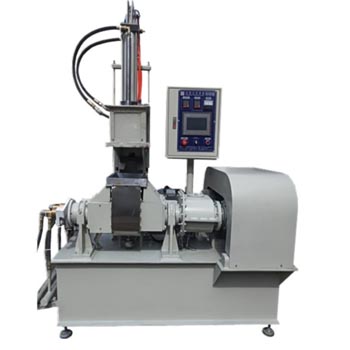Lab kneader equipment also called a laboratory kneader or sigma kneader, it is a high-shear, high-torque mixer used for kneading and mixing materials that are too thick or sticky for traditional mixers. The Lab kneader machine for high-viscosity materials feature with heavy-duty internal mixer which are specially equipped with intermeshing blades, usually sigma-shaped blade,which rotate in different speed in opposite direction inside a closed mixing chamber.
Basically ,the lab kneader is specially engineered to handle sticky, dough-like, or highly viscous materials which require strong shear and intensive mixing.
How Lab Kneader Works for High Viscosity Materials
1. High Torque Blades for Powerful Shear
The kneader’s sigma blades rotate at different speeds, which generate intensive kneading and shearing force to the material . This mechanical force breaks down lumps and distributes fillers, additives, or plasticizers evenly—even when the material resists flow due to its thickness.
2. Efficient Material Movement
It is the fact that , in high viscosity scenarios, the compound material doesn’t flow freely like a liquid. Thus the lab kneader is specially designed to move and fold the compound material repeatedly within the mixing chamber, which ensure uniform dispersion. The slow yet powerful motion allows every part of the compound to be blended thoroughly.
3. Temperature Control for Viscosity Management
Many lab kneaders may be equipped with jacketed chambers ,which can be used for heating or cooling function. Generally , after heating the compound material slightly ,it can lower viscosity of material just enough to improve flow and dispersion, while by way of cooling , it may be needed to avoid thermal degradation during long mixing cycles.
4. Vacuum Function for Bubble Removal (Optional)
Some model lab kneader can also custom and tailored as per specific function, they can be tailored with vacuum function, which allow to remove the inner air during mixing process. This is also essential for certain high-viscosity materials like silicone rubber or specialty adhesives where air bubbles can ruin product integrity.
5. Programmable PLC System
Advanced lab dispersion kneaders can be custom and equipped with PLC touchscreen control system ,which allow users to set precise mixing time, blade speed, and temperature . This automation save much time for user as it don’t need manual to monitor the machine running ,it is very critical for reproducible results in R&D or sample production.
Benefits for High Viscosity Material Processing
* Homogeneous Mixing even in ultra-thick, semi-solid materials
* Reduced Batch Time thanks to high-efficiency mixing action
* Accurate Temperature Management to optimize processing
* Small Batch Capability for pilot scale and formulation testing
* Customizable Design for different industries (rubber, plastics, pharma, food, etc.)
Which High Viscosity Materials Can be Hangle with Lab Kneader
The Lab kneaders are versatile and widely used across multiple industries:
* Rubber compounds (NR, SBR, EPDM, etc.)
* Silicone paste & blending
* Battery slurry.Cathode/anode slurry mixing
* Thermosetting resin compounds
* High-density adhesives
* Color masterbatches
* Hot-melt sealants
* Adhesive formulation (hot melt, PU, epoxy)
* Plastic color masterbatch
* PVC pastes, color masterbatches
* High-viscosity chemical paste or putty
* Pharmaceuticals & Cosmetics:Ointments, thick creams, gels
Therefore ,If you are working with tough-to-handle materials, a lab kneader is not just an option—it’s a necessity. The compact lab kneader provides the mixing strength, control, and reliability needed to process high-viscosity formulations in a consistent and scalable way.
Whether you’re in R&D or small-batch production, the Small-scale kneader mixer for R&D ensures your thickest materials are thoroughly and efficiently blended.







